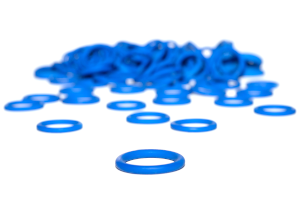FVMQ O-RINGS | MATERIALS SIMPLY EXPLAINED
What are FVMQ O-rings?
Silicone stands out from other elastomer materials for the manufacture of seals due to one key property: Components made from this material retain their mechanical properties over a very wide temperature range.
From the absolute low temperature range at -60 degrees to the upper application limit at +200 degrees, this makes reliable sealing possible for O-rings – ideal for applications with strong temperature fluctuations.
FMVQ is one of the two rubbers in this Q-group that are chemically characterized by the fact that they have silicone in the main group.
This fluorosilicone rubber is a comparatively recent development of the silicone rubber VMQ. The developers have succeeded in retaining the already very good properties of VMQ and extending the resistance profile to include fossil fuels.
This is also the main area of application for FVMQ O-rings. FVMQ is ideal wherever a broad temperature spectrum and fuels or mineral oils come together as media.

Feature | Value |
|---|---|
ISO designation | FVMQ |
Trade names | None |
Chemical name | Fluorosilicone rubber |
Media resistance | Good media resistance |
Temperature resistance | -60°C to +200°C |
Standard color | Blue |
Standard hardness | 70 Shore A |
Industries | Oil&Gas, Automotive industry |
Production | Compression molding and injection molding |
Tolerances | DIN ISO 3601 |
Durability | 10 years |
REQUEST FVMQ O-RINGS QUICKLY AND EASILY?
Almost any dimension available
Over 10,000 FKM dimensions available from stock
Offer received in record time
No minimum order values or minimum quantities
#1 The 5 most important advantages of FVMQ O-rings
1. Low compression set
2. Very good low-temperature flexibility
3. Excellent chemical resistance
4. Insensitivity to ozone and weathering
5. Good electrical properties
Due to their mechanical properties, FVMQ O-rings are only suitable for static seals, just like VMQ O-rings.
On the other hand, their low compression set but optimal. This is because even if components that are not actually moving are to be sealed against each other or against the environment, changes in their positioning can occur.
External influences can be just as responsible for this as changes in pressure conditions or vibrations.
The low compression set of FVMQ O-rings ensures that they relax and return to their original shape even after a prolonged compressive load. This is the most important prerequisite for achieving a modified sealing gap can be reliably covered.
Hardly any other gasket material shows this advantageous behavior over such a wide temperature range.
In addition, FVMQ O-rings are highly resistant to chemicals. Compared to the base material VMQ, FVMQ is also more durable in contact with oils, fuels and solvents.
Together with their excellent resistance to ozone and weathering, this allows FVMQ O-rings to be used for extremely demanding applications such as fuel systems in the aerospace and automotive industries.
A comparison of the most important O-ring materials
Material | Temperature resistance | Chemical resistance | Elasticity |
|---|---|---|---|
NBR | -30°C to +120°C | Low | High |
HNBR | -30°C to +150°C | Medium | High |
EPDM | -45°C to +150°C | Medium | High |
SILICONE | -60°C to +200°C | Low | High |
FKM (VITON) | -25°C to +200°C | Medium | High |
FEP coated | -60°C to +200°C | High | Medium |
PTFE | -250°C to +250°C | High | Low |
FFKM | -40°C to +340°C | High | High |
#2 The 3 most common areas of application for FVMQ O-rings
AUTOMOTIVE INDUSTRY
Fuel-carrying systems such as pipes, the tank system or the injection system are among the most critical applications for O-rings.
Modern engine technology places high demands on the tightness of the fuel system, while at the same time high pressures prevail.
New types of fuel, which increasingly come from renewable raw materials, are also changing the requirements for media resistance. FVMQ O-rings are mainly used in this environment for sealing pipes and couplings.
The sealing elements are equally suitable for normal, super fuel and diesel. Compared to the alternative materials NBR and FKM FVMQ has the advantage of better low-temperature flexibility.
AIR and space travel
The technical systems in the aerospace industry naturally place particularly high demands on the temperature range of sealing elements.
After all, the operating conditions can alternate between high heat and very low temperatures.
O-rings made of FVMQ are very frequently used in this area. They owe their suitability above all to their excellent low-temperature flexibility and resistance to many common media.
OIL AND GAS INDUSTRY
Sealing applications in the oil and gas industry are also characterized by particularly high requirements.
FVMQ O-rings enjoy a very high status here due to their insensitivity to weather influences and their resistance to mineral oil-based products.
#3 What is the media resistance of FVMQ O-rings?
VMQ is usually a peroxide-cured fluorosilicone rubber. Fluorination adds oils, fuels and solvents to the resistance profile of silicone rubber.
It is precisely this, in combination with the extraordinary low-temperature flexibility, that opens up the most important areas of application for FVMQ O-rings.
FVMQ O-rings are resistant to:
- Engine and gear oil
- Aromatic mineral oils
- Alcohol-free fuels
- Vegetable and animal oils and fats
- Glycol-based brake fluids
- Flame-retardant hydraulic media (HFD-R and HFD-S)
- High molecular weight chlorinated hydrocarbons
- Water up to 100 degrees
FVMQ O-rings are not resistant to:
- Low molecular weight aromatic hydrocarbons
- Low molecular weight esters and ethers
- Superheated water vapor above 120 degrees
- Acids
- Alkalis
- Silicone oils
Compared to VMQ, FVMQ is less resistant in contact with hot air. In many applications, however, the gains in media resistance in the area of mineral oil-based media are the decisive factor for the use of FVMQ O-rings.
In the past, VMQ was replaced by the materials NBR or FKM if the application involved contact with gasoline or oil – at the expense of flexibility at low temperatures.
FVMQ now closes this gap. The O-rings combine the cold resistance typical of silicone with the corresponding chemical stability. The decisive factor here is the swelling in the media contact. It should be as low as possible.
FVMQ is on a par with HNBR and NBR. In terms of fuel resistance alone, however, the market offers even better-performing alternatives with O-rings made of FFKM, FKM or ACM.
#4 What is the temperature resistance of FVMQ O-rings?
FVMQ O-rings have a temperature resistance of -60°C to +200°C . However, this specification applies primarily to the ambient medium air.
If the O-rings come into contact with other media during operation, the temperature resistance may be correspondingly lower, depending on compatibility.
For example, the media-specific temperature limits of FVMQ in contact with water are 100 degrees. However, FVMQ also reaches the upper temperature limit of 200 degrees on mineral oil-based products.
This means that the FVMQ material has a comparable temperature range to EPDM. However, VMQ can withstand hot air at even higher temperatures of up to 210 degrees. This is where FVMQ loses out somewhat in comparison.
#5 What are the mechanical properties of FVMQ O-rings?
1. very low abrasion resistance
2. moderate to medium mechanical strength
3. low compression set
The mechanical properties of FVMQ are very similar to those of VMQ. Therefore the dynamic use of FVMQ O-rings should therefore be avoided.
The low abrasion resistance ensures that the material wears out quickly. The friction between the sealing surfaces causes abrasion, which can contaminate the media.
In addition, the sealing effect is quickly lost because sealing gaps can no longer be adequately covered at their widest point.
Apart from this, the mechanical strength of FVMQ O-rings is moderate to medium. Compressive strength is a limiting factor. Under high pressure, O-rings made of FVMQ are easily pressed into the sealing gap and permanently damaged.
However, the low compression set, which the material maintains over an extremely wide temperature range, is a positive feature.
#6 What do I have to consider when designing the groove of an FVMQ O-ring?
Groove design of FVMQ O-rings
- Make groove design according to ISO 3601
- Reduce the sealing gap by 50% compared to other elastomers
- Ensure minimum compression of the cross-section of 6%
- Secure the O-ring against excessive pressure with a support ring
- Select manufacturing processes with a special focus on tolerances
FVMQ and VMQ are poorly suited for pressure applications, so designers should select a smaller sealing gap than for the other common elastomers.
Assembly of FVMQ O-rings
- Provide insertion slopes between 15 and 20 degrees
- Deburr drill holes, even if they are only passed over during assembly
- Round off sharp edges with a minimum radius of 0.1 to 0.3 mm
- Use suitable mounting aids such as mounting cones to prevent overstretching
- Avoid twisting the O-ring
Important: FVMQ is not resistant to silicone oils. Therefore, when assembly Therefore, no silicone-based greases or oils should be used during installation in order to avoid media attack.
#7 Further important information on FVMQ O-rings
Finally, we would like to answer a few questions that we are frequently asked in everyday life.
#7.1 What is the FVMQ material made of?
FVMQ is usually a peroxide-cured fluorosilicone rubber.
Fluorination adds oils, fuels and solvents to the resistance profile of silicone rubber.
It is precisely this, in combination with the extraordinary low-temperature flexibility, that opens up the most important areas of application for FVMQ O-rings.
#7.2 Is there a data sheet for the FVMQ O-rings?
You can easily view the data sheet for our FVMQ O-rings directly on our website and download it if you wish.
#7.3 What is the FVMQ consistency?
In principle, FVMQ O-rings are permanently resistant from -60°C to +200°C.
It is important to note that the temperature resistance only applies to the medium “air”.
In addition, FVMQ O-rings have significantly better media resistance compared to simple silicone O-rings due to their fluorine content.
#7.4 Are FVMQ O-rings food-safe?
Yes, all our FVMQ O-rings are food-safe.
This means that the O-rings are approved in accordance with the guidelines of the FDA (Food and Drug Administration).
“I am convinced that we should share our knowledge with the world. I hope I have been able to answer all your questions. If you have any further questions, please feel free to contact us at any time. We will be happy to help you.”

Lord of the O-rings
Author of the sealing academy
